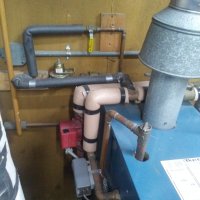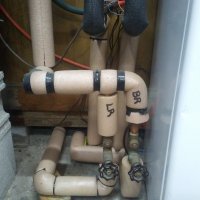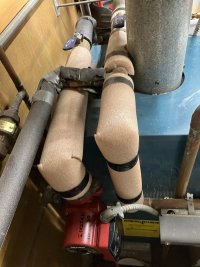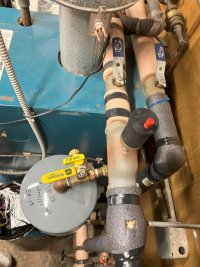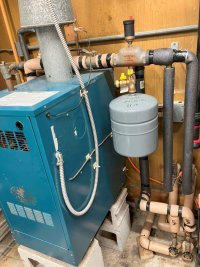Hello , I have a Burnham Boiler that is 27 years old with 2 Taco zone valves with of course to separate thermosets and one circular pump which is on return side and air scoop with high vent on supply side. My issue is that I had to replace my circular pump before fall of this year and the pump i replaced was a single speed with no check valve (gundfos 25 years old ) with a new gundfos 3 speed with a check valve in it ( they don't sell the old style anymore that i just replaced ) Ever since I replaced this pump I have been having issues getting all the air out of each zone I have bleed each zone with the by pass from the auto fill on to increase the pressure without popping the PRV .I would let each zone bleed into 5 gallon buckets to where I would get at least 6 buckets of water to dump before i would switch to the next zone and repeat the same process after I feel that i have all the air out of the zones I would reverse the process as shut the by pass off reclose zone vales and reset taco zone vales back to auto then fire it back on again and would hear air coming through the pump which i thought my air scoop would remove what was left but i guess not. I'm wondering is the way I'm trying to bleed this unit is incorrect or I'm just not bleed this thing right ? Or could it be the check valve should not be in ?
You are using an out of date browser. It may not display this or other websites correctly.
You should upgrade or use an alternative browser.
You should upgrade or use an alternative browser.
Issues bleeding air from boiler
- Thread starter Grog66
- Start date
Users who are viewing this thread
Total: 3 (members: 0, guests: 3)
Fitter30
Well-Known Member
Don't mention any air eliminator device in system which every system needs . Need some pics of boiler, pump, ex tank and zone valves. With boiler,& pump off zone valves open wait a hour or two don't know what type of heat emitters u have but bleed them air will find the highest spot.
Sponsor
Paid Advertisement
John Gayewski
In the Trades
With your pump on the return side your going to have a much harder time getting air out of your system. I'm gonna doubt you'll want to change your system configuration to a system that pumps away from the boiler and expansion tank both but it would make your life easier. Your pump should be pushing the air out and in turn making the air bubbles smaller, vs pulling on them and stretching them out.
A spirovent will also make a big difference as it actually screens the air out vs a traditional air scoop which let's only bubbles that happen to float at the top of the piping in that exact spot, come out.
A spirovent will also make a big difference as it actually screens the air out vs a traditional air scoop which let's only bubbles that happen to float at the top of the piping in that exact spot, come out.
These are a few ,more to come .Number 4 photo shows the two ball valves , 1st one is supply with the high vent attached to the air scoop with expansion tank which I do know the tank should be a 30 instead of 15 ( 15 was originally installed when unit was put in 27 years ago and had no pressure issues until last year then I replaced with a new 15 ) 2nd ball valve is the return This would be the valve that I close to bleed and leave the 1st ball valve open then I would hook a hose up to the return drain for zones as in picture 2 /5 then manually open the zone that the hose is draining from of the taco zone valve and run the auto fill by pass for force feed water making sure pressure doesn't exceed 25 then run until i see a steady stream of water and switch to next zone and repeat .I have baseboard heat closed loop with no bleeders at the baseboards ( copper pipe slant fin baseboards ) single story home. Expansion tank with bladder was replaced last year before winter started with no bleeding needed but pump replaced this fall but needing bleeding which didn't surprise me that it needed bleed, that's when the air issues started.
Attachments
Last edited:
John Gayewski
In the Trades
Safe? 160 is pretty hot and will burn you pretty quickly.What would be a suggested temperature reading for the boiler so I could try to bleed the zones ? would it be safe if the temperature of 160 degrees to be ok to start bleeding ?
140 will take about ten seconds or so to burn you.
I'd go below 140.
Fitter30
Well-Known Member
Correct if im wrong pump is the return of the boiler, out of the boiler going through the ex tank and air scoop. What pressure is the boiler gauge? Is the red cap on air scoop loose?
Yes you are right about how the flow goes .Pressure is 18psi at around 194 degrees after boiler shuts off ,cold would be around 13/14 psiCorrect if im wrong pump is the return of the boiler, out of the boiler going through the ex tank and air scoop. What pressure is the boiler gauge? Is the red cap on air scoop loose?
John Gayewski
In the Trades
If your temp at the boiler is 140 then your return water should be around 120. Running that way for a day isn't going to hurt anything and it won't shock the boiler into cracking.Ok , I was more worried about the cold water going into boiler after bleeding so that it doesn't do any damage. Thanks John
Over time running those temps will carouse the boiler to condensate acid that will over time possibly damage the boiler. But depending on the cast iron quality and thickness, there are boilers that can run like that for 20 or thirty years and they definitely have.
Generally you don't want a cast iron boiler to condensate, but for short periods it's fine. What you don't want is a boiler that is 180 degrees with water coming back at 120 or 100 as that can cause a crack. Even then it's very dependant on the cast iron quality and construction. Like heating up a glass jar and dropping it in cold water. The further the temps get from one another the more likely it'll crack and it depends on the glass, and it's shape can make a difference.
Fitter30
Well-Known Member
What to rid of the air problems move the pump to the other side of boiler downstream of ex tank change the air scoop for spirotherm. Have you seen if the cap on the air scoop loose? Remove it and depress the valve with a screwdriver water or air should come out.
Similar threads
- Replies
- 0
- Views
- 61
- Replies
- 2
- Views
- 350
- Replies
- 2
- Views
- 687

